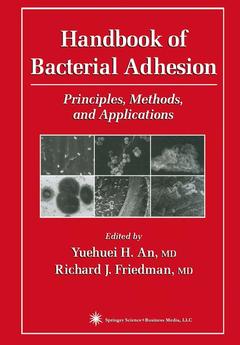Description
Handbook of Bacterial Adhesion, Softcover reprint of hardcover 1st ed. 2000
Principles, Methods, and Applications
Coordinators: An Yuehuei H., Friedman Richard J.
Language: English
Subject for Handbook of Bacterial Adhesion:
Keywords
Biomaterial; Monitor; Stent; bacteria; bioengineering; cells; endothelium; medical devices; molecular basis; tissue
Publication date: 11-2010
644 p. · 17.8x25.4 cm · Paperback
644 p. · 17.8x25.4 cm · Paperback
Description
/li>Contents
/li>Comment
/li>
Research on bacterial adhesion and its significance is a major field involving many different aspects of nature and human life, such as marine science, soil and plant ecology, most importantly, the biomedical field. The adhesion ofbacteria to the food industry, and human tissue surfaces and implanted biomaterial surfaces is an important step in the patho genesis of infection. Handbook 0/ Bacterial Adhesion: Principles, Methods, and Applications is an outgrowth of the editors' own quest for information on laboratory techniques for studying bacte rial adhesion to biomaterials, bone, and other tissues and, more importantly, a response to significant needs in the research community. This book is designed to be an experimental guide for biomedical scientists, biomaterials scientists, students, laboratory technicians, or anyone who plans to conduct bacterial adhesion studies. More specifically, it is intended for all those researchers facing the chal lenge of implant infections in such devices as orthopedic prostheses, cardiovascular devices or catheters, cerebrospinal fluid shunts or extradural catheters, thoracic or abdominal catheters, portosystemic shunts or bile stents, urological catheters or stents, plastic surgical implants, oral or maxillofacial implants, contraceptive implants, or even contact lenses. It also covers research methods for the study of bacterial adhesion to tis sues such as teeth, respiratory mucosa, intestinal mucosa, and the urinary tract. In short, it constitutes a handbook for biomechanical and bioengineering researchers and students at all levels.
I — Mechanisms of Microbial Adhesion and Biofilm Formation.- 1. Mechanisms of Bacterial Adhesion and Pathogenesis of Implant and Tissue Infections.- 2. Molecular Basis of Bacterial Adhesion.- 3. Molecular Genetics of Bacterial Adhesion and Biofouling.- 4. Factors Influencing Bacterial Adhesion.- 5. Nonspecific Staphylococcus epidermidis Adhesion: Contributions of Biomaterial Hydrophobicity and Charge.- 6. Effects of Surface Roughness and Free Energy on Oral Bacterial Adhesion.- II — General Considerations and Methods for Studying Microbial Adhesion and Biofilm.- 7. Basic Equipment and Microbiological Techniques for Studying Bacterial Adhesion.- 8. General Considerations for Studying Bacterial Adhesion to Biomaterials.- 9. Laboratory Culture and Analysis of Microbial Biofilms.- 10. Monitoring the Organization of Microbial Biofilm Communities.- 11. Models and Measurement of Bacterial Growth Rates on Polymers.- 12. Analysis of Gene Expression in Biofilm Bacteria.- III — Techniques for Studying Microbial Adhesion and Biofilm.- 13. Methods for Evaluating Attached Bacteria and Biofilms: An Overview.- 14. Evaluating Adherent Bacteria and Biofilm Using Electron Microscopy.- 15. Confocal Laser Scanning Microscopy for Examination of Microbial Biofilms.- 16. Quantitation of Bacterial Adhesion to Biomaterials Using Radiolabeling Techniques.- 17. Evaluating Adherent Bacteria and Biofilm Using Biochemical and Immunochemical Methods.- 18. Evaluating Bacterial Adhesion Using Atomic Force Microscopy.- 19. Direct Measurement of Long-Range Interaction Forces Between a Single Bacterium and a Substrate Using an Optical Trap.- IV — Studying Microbial Adhesion to Biomaterials.- 20. Staphylococcal Factors Involved in Adhesion and Biofilm Formation on Biomaterials.- 21. StudyingBacterial Adhesion to Irregular or Porous Surfaces.- 22. Studying Bacterial Colonization of Tubular Medical Devices.- 23. Studying Plaque Biofilms on Various Dental Surfaces.- 24. Studying Bacterial Adhesion to Biliary Stents.- 25. Studying Bacterial Adhesion to Hydrogel Contact Lenses.- 26. In Vivo Models for Studying Staphylococcal Adhesion to Biomaterials.- V — Studying Microbial Adhesion to Host Tissue.- 27. Characterization of Staphylococcal Adhesins for Adherence to Host Tissues.- 28. Studying Bacterial Adhesion to Tooth Surfaces.- 29. Studying Bacterial Adhesion to Respiratory Mucosa.- 30. Studying Bacterial Adhesion to Endothelial Cells.- 31. Studying Bacterial Adhesion to Gastric Epithelium.- 32. Studying Bacterial Adhesion in the Urinary Tract.- 33. Studying Candida albicans Adhesion.- 34. Studying Bacterial Adhesion to Cultured Cells.- VI — Strategies for Prevention of Microbial Adhesion.- 35. Strategies for Preventing Group A Streptococcal Adhesion and Infection.- 36. Changing Material Surface Chemistry for Preventing Bacterial Adhesion.- 37. Antimicrobial Agent Incorporation for Preventing Bacterial Adhesion.- 38. Studying Bacterial Adhesion to Antibiotic Impregnated Polymethylmethacrylate.- 39. Macromolecule Surface Coating for Preventing Bacterial Adhesion.- Appendix 1.
Includes supplementary material: sn.pub/extras
© 2024 LAVOISIER S.A.S.




